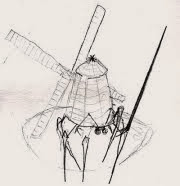So yeah, needle crystals diminish in thickness when dissolving.
But they increase in length when 'un-dissolving' (or is that 'solving'?)
Subtleties, subtleties, subtleties ... the reaction is reversible, but it does not follow the same path.
Next time I do time lapse, I'm going to include a clock face in the frames to keep track of the flow of time. This one had a frame timing of about 3 seconds, and a total time of 85 seconds. Compressed to 5 seconds, we're looking at 17:1 acceleration.
I've got a small jar of saturated ammonium nitrate solution lying around, and it was casually exposed to -20C temperatures. The result is readily predictable ; a bunch of solute fell out of solution, and the tiny needle crystals at the bottom of the jar became honking big crystals.
I warmed it back up and everything ran backwards. It takes about twenty minutes to chill the solution down enough for the crystals to grow about 20X in length, so it occurred to me to shoot before and after pixs.
Then I thought about setting up a time lapse sequence. Among the problems of lighting and pose (still not yet settled), I wondered about keeping the camera warm and the bottle unfogged.
Inspiration strikes:
Oh wait, I don't need to chill the bottle, I can just let it warm up and reverse the sequence of photos. The video of crystals dissolving is the same as crystal growing.
Or is it? The crystals are needle-shaped, which implies that there is preferred points of growth, whereas dissolution should occur over the entire surface simultaneously, causing the crystal to get thinner faster than it gets shorter.
I am delighted by the question, and intend to test it.
I warmed it back up and everything ran backwards. It takes about twenty minutes to chill the solution down enough for the crystals to grow about 20X in length, so it occurred to me to shoot before and after pixs.
Then I thought about setting up a time lapse sequence. Among the problems of lighting and pose (still not yet settled), I wondered about keeping the camera warm and the bottle unfogged.
Inspiration strikes:
Oh wait, I don't need to chill the bottle, I can just let it warm up and reverse the sequence of photos. The video of crystals dissolving is the same as crystal growing.
Or is it? The crystals are needle-shaped, which implies that there is preferred points of growth, whereas dissolution should occur over the entire surface simultaneously, causing the crystal to get thinner faster than it gets shorter.
I am delighted by the question, and intend to test it.
Labels:
crystal growth,
solution,
time lapse
Subscribe to:
Posts (Atom)

